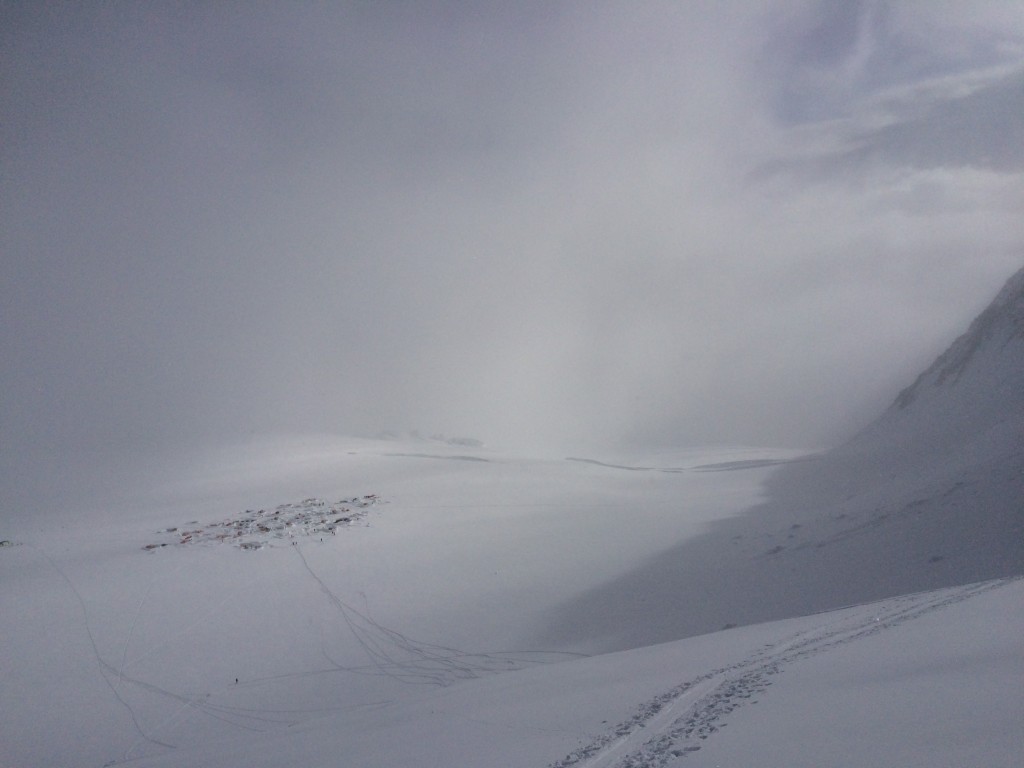
Thick clouds like this one, here seen from the base of the fixed lines above 14 camp, frequently made travel on the upper mountain difficult to impossible during our expedition. Photo: Ian Bolliger
It was both a straightforward and heartbreaking decision. With just one scheduled day left in the trip, my skiing partner, Peter, and I found ourselves standing for the third time in the middle of high camp on Denali, at 17,200 feet, staring at a dark, foggy, and seemingly indomitable upper mountain. Several hours earlier, having woken optimistically to blue skies and warm temps, we had set off from camp at 14k with the summit in mind. No sooner had we put skins on than the thick soup in which we had been marooned for the last week crept up from lower elevations to envelop us in its nothingness.
The winds and snow went back to their now familiar tricks, buffeting us as we climbed the ridge above 16k. Arriving at 17k, we observed the upper mountain being swallowed by an ominous storm cloud. I was the first to voice our foregone conclusion.
“I’m done,” I said matter-of-factly, a departure from the hemming and hawing that had pervaded our decision-making during the past week of questionable weather.
It was the right call. Yet when we started down the ridge from 17k for the final time, having never set foot above this camp, I knew that the knot in my stomach was more than just that morning’s oatmeal.
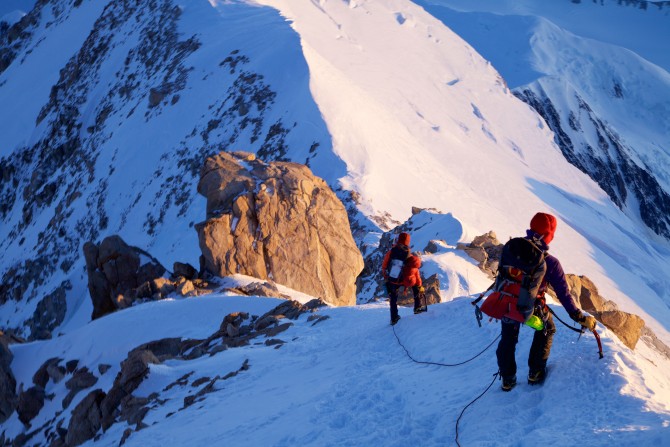
The rest of the team descending from 17k several days after my departure. Photo credit: David Leonard
The expedition began not with our flight into basecamp, but several months earlier. Purchasing our permit 60 days in advance was the first step of commitment (which is an attribute I’ve been told I struggle with) but ultimately helped get the ball rolling. As the planning process unfolded, I reached out to a group called Adventurers and Scientist for Conservation (ASC), who pair scientists needing data from remote areas with those who have the means to collect it. One of their scientific partners is aiming to quantify high-altitude glacial melting and requires snow samples from these environments. (Check out the story speaking specifically to this snow sampling expedition available on adventurescience.org.) As a graduate student studying climate science, I was eager to participate. The rest of the group was on board too, so we agreed to help.
Peter and I flew in to the Kahiltna Glacier a couple days before Dave and Hollie, the other members of our team, and were able to ski several lines around basecamp during this time. On our first day, we headed toward the Southeast Ridge of Mt. Frances. We split from the standard non-technical route before arriving at the ridge proper, electing to boot up a skiable, 1,700-foot couloir.

Peter boots up a couloir departing from the SE ridge of Mt. Frances.
After topping out the couloir, the summit ridge brought horrendous flat light and spots of blue ice. We ditched poles in favor of an axe for the way down, and survival-skied from the summit to the couloir entrance. From there we scratched our way down the icy chicken-headed chute, hopped the schrund at the bottom, and made our way back to camp.
On Day 2, we skied from the Cat’s Ears on the West Ridge of Mt. Hunter. The sun was out for the first time and the views from the Ears were unbelievable.

Peter contemplates the enormity of Mt. Foraker and the Alaska Range from beneath the Cat’s Ears on Mt. Hunter.
We enjoyed another icy ski down, which probably could have been avoided had we elected to start a little later and let the sun bake those slopes.

Our cooktent at Camp 1, with the Northeast Fork of the Kahiltna and an ominous lenticular over Denali’s summit serving as backdrop.
Once Dave and Hollie arrived and we waited out a day of bad weather, we packed up and headed to Camp 1. This was my first experience pulling a sled and, needless to say, I greatly prefer riding in one.
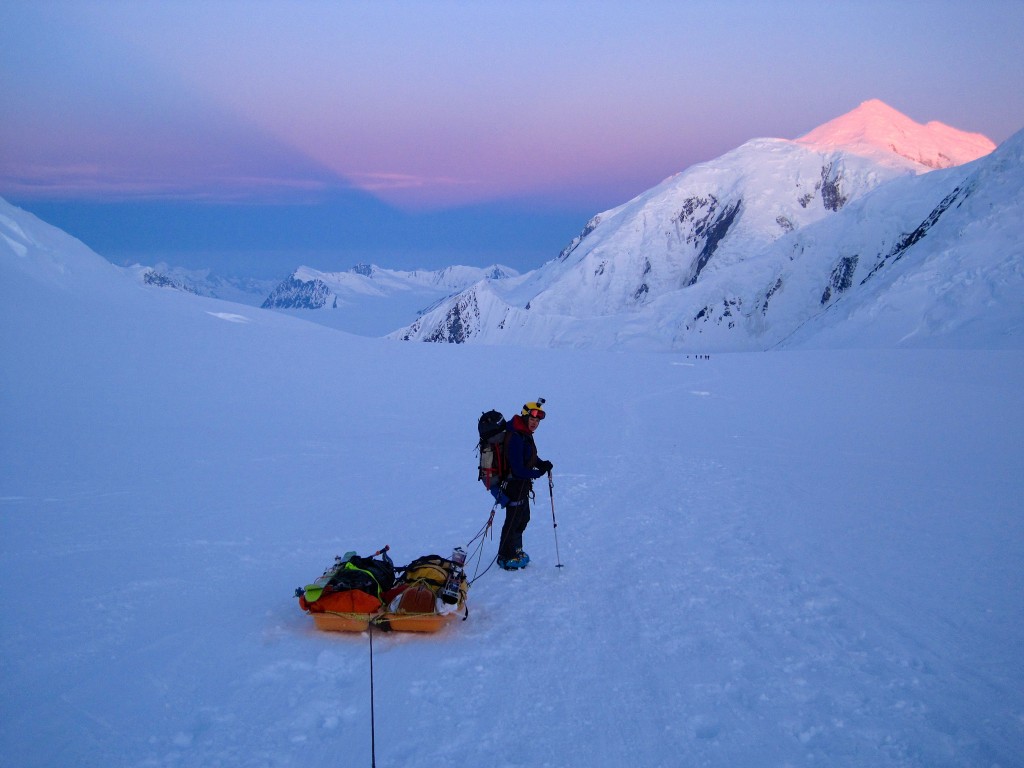
These sleds became a constant, yet quite unwelcome, companion during our time on the lower mountain. Here, some creative rigging allowed for this double-wide trailer-style on the way down from 11k camp. Photo credit: David Leonard
When we finally arrived, exhausted, we were greeted with intense fog and the start of another mild snowstorm. After this weather passed we double-carried to 11k camp. While perhaps overly conservative, this approach did allow us to ski sled-free down the gentle slopes linking the two camps.

11k was when we finally started to get the “big mountain” feel. The view from this camp on sunny days is hard to beat.
This may be the most beautiful run I’ve ever taken, and I highly recommend it. When the double carry was complete, we rested for a day before making our first carry to a cache at 13.5k.

It was an icy skin up Squirrel Hill to get to 14k camp. Our friends Sam and Paul can be seen setting the track ahead of us.
On the way down from this cache, a minor disaster struck when my Dynafit heelpiece snapped in half during a benign turn. We ended up using a ski strap to lash my boots to the half of the heelpiece still screwed into my ski, an approach that worked surprisingly well.
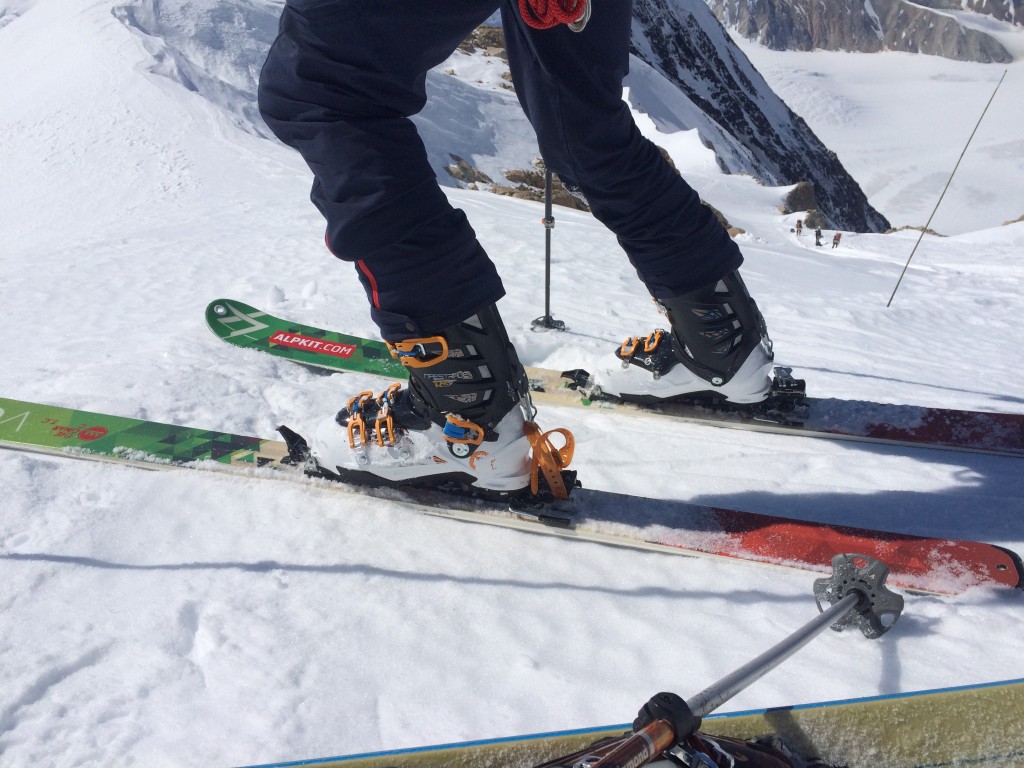
We constructed an emergency “binding” with a ski strap that functioned surprisingly well following the explosion of my heelpiece.
Following Murphy’s Law, I had of course brought a spare toe-piece with me but not a heel-piece. Luckily, a couple friends of mine happened to be at 11k with us and one of them had left a spare heel at basecamp. Peter volunteered to ski down with me, and the two of us set off that evening to dig up this buried treasure.
Though it had taken us four days to get to 11k, it took us only an hour and a half to ski down. We grabbed the spare piece, crashed in the tents of some friends at basecamp, and returned the next morning. Without sleds and heavy packs weighing us down, it was just a six-hour trip back to 11k. Despite the positive outcome, this experience made me less confident in the durability of my bindings. On my next expedition, I will certainly bring a full spare.
On the following day we bumped to 14k, and on the day after we took a trip up to the base of the fixed lines that stand 1,000 feet above camp. The skiing was a bit scratchy but the setting once again picturesque. Unfortunately, this would be the last of the beautiful weather as a series of low-pressure systems would blast the mountain – and our summit hopes – for the next week and a half.
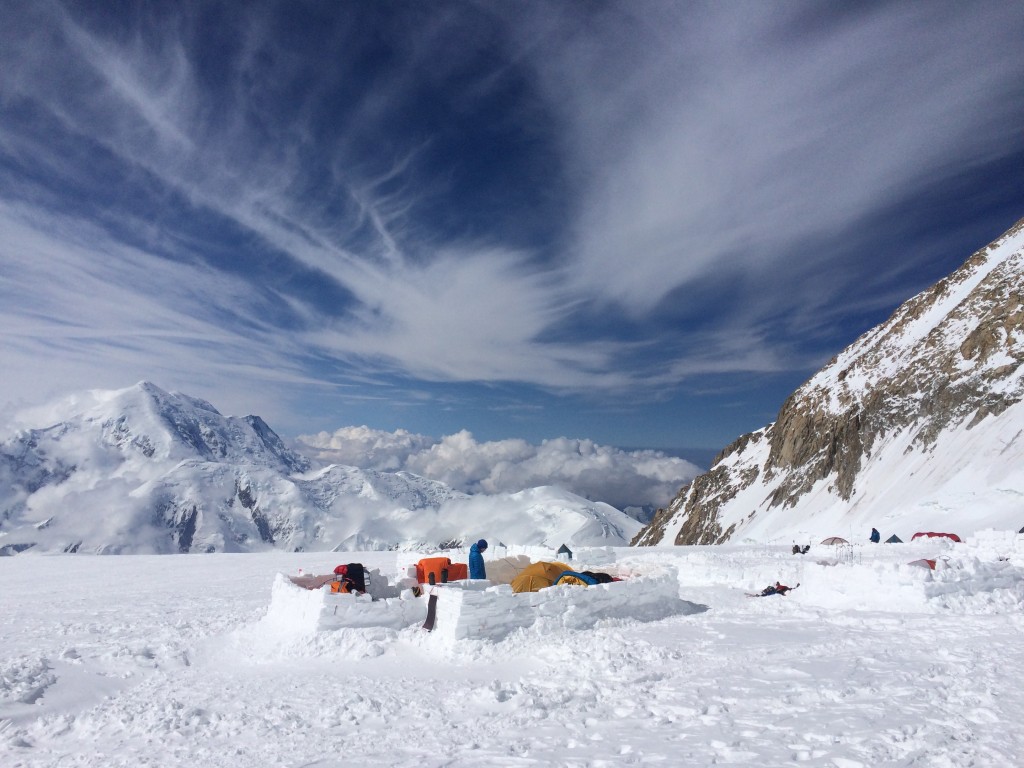
Our camp at 14, as seen on the last day of high-pressure before we entered the prolonged misery of a series of storms.
Unfortunately, because of the weather, there is not as much to report about the final week and a half of the trip. We rested, we skied the headwall above 14 several times, and we made three separate pushes to 17k.

Peter skinning up the headwall above 14k camp and below the fixed lines.
The first time was purely for acclimation. On the second, we had intended to reach 18 or 19k but turned around due to the weather.
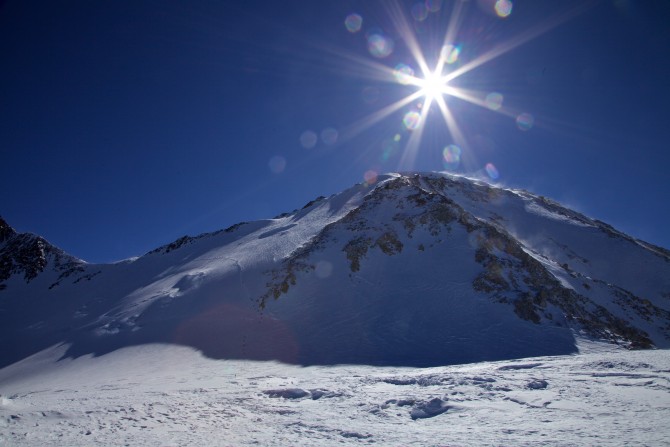
Dave captured this beautiful view of the upper mountain from 17k camp a couple days after I had left the mountain. If you zoom in, you can pick out a string of climbers on the “Autobahn”, the traverse stretching across the large left-facing snow slope in the photo. Photo credit: David Leonard
After this first trip, with only four days left before my scheduled flight out of Anchorage, we decided to rest two days and make a final push from 14k. A one-day window between systems was supposed to occur, but as the day got closer, the forecast got worse. Ultimately, it wound up being yet another storm day and, as mentioned earlier, wreaked havoc on our summit bid.
Coming down from that attempt, I was frustrated, tired, and eager to get off the mountain before the weather deteriorated further. Upon returning to camp, I hurriedly packed up my gear as the familiar fog moved in and out. With “real-world” commitments looming, I elected to push through the questionable weather and descend solo while the others in the team stayed for several more days.
The next six hours were some of the most terrifying that I have spent in the mountains. A total lack of visibility accompanied my sled and me as we made our way down. It was surreal travelling through the wind, snow and fog seemingly without another soul on the mountain. Numerous times I debated bivvying where I stood, since I was unable to make out the next wand that would mark a safe path. For several hours, I followed a monotonous yet nerve-wracking pattern. I would reach one wand, then get on my hands and knees to look for the track of a sled, slowly venturing out along this path until I could spot the next wand. In some cases, I’d push my sled in front of me as an admittedly poor test for crevasses. I don’t recommend this haphazard technique and, were I to do this day over again, I would certainly have stayed at 14k until the weather cleared. Flying out of Anchorage in time was not worth the risk of that descent.
I eventually arrived at basecamp to find a queue of roughly 70 climbers waiting to fly out. The bad weather had put a stop to any incoming or outgoing flights for the last 3 days, and folks at camp were starting to get antsy. Luckily, I only had to spend 24 hours there before a brief window arrived and the flight companies sent the full armada to rush climbers in and out.

After a several-day weather hold, large queues of climbers awaiting transport built up both at basecamp and in town. When the weather finally broke, basecamp truly earned its nickname of “Kahiltna International Airport”.
Upon arriving in Talkeetna and immediately showering, I made my way to a massive dinner with three friends who had flown out a few hours before me. As is tradition when returning from the Range, we next found ourselves at the Fairview Inn. Here climbers, locals, bikers, and tourists come together to form one of the most eclectic groups of heavy-drinking partiers I’ve seen. Rounds of beers gave way to a late-night dance party, which in turn rolled into an early morning trip to the riverfront. There, several people had MacGyver’d a hot tub by building a fire underneath a giant cast-iron container. As several nights of sleeplessness caught up to me, I eventually made my way back to my hostel and immediately crashed, content to be sleeping on a mattress that I hadn’t recently inflated.
In the days since the expedition, I’ve debated whether the part of me wanting to return immediately to Denali and reach the summit is larger than the part wishing to avoid the masses, the unforgiving weather, and the tremendous time commitment involved in this sort of expedition. I think that I’ll head back at some point; the Orient and Messner couloirs beckon, and summiting would be even sweeter having failed this first time. Yet before that, I would like to explore other parts of the Range or perhaps ski some of the Aleutian volcanoes. While the immediacy of my return to Denali is in question, the inspiration I have found in Alaska is not. From skiing on the Pika Glacier to a weekend trip to Valdez to this recent month spent on North America’s highest peak, I have repeatedly been blown away by the magnitude and beauty of the state’s rugged mountains. If you ever get the chance to ski, climb, or simply view any of them in person, I strongly recommend that you do not pass up the opportunity.
Author’s Note: I am extremely grateful for the support of the American Alpine Club and their Live Your Dream grant. Without this funding, I likely would not have been able to participate in this adventure and gain this incredible expedition experience. The intentions of the grant are to push one’s personal boundaries and explore new territories, and it certainly helped me to achieve these goals with this trip. I encourage all ambitious amateur climbers who have a trip in mind to apply.

